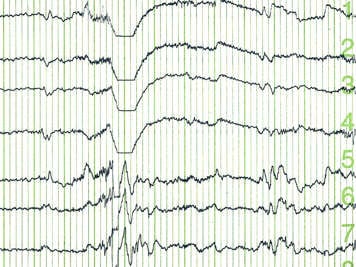什麽是腦電圖 (EEG)?

大腦內的細胞運用低層次電進行互相交流。腦電圖 (EEG) 隨著時間測量這種電力。大腦的電活動在電腦監控器上顯示爲波綫。醫生能够通過查看波綫瞭解大腦的工作情况。
進行 EEG 的原因
醫生通過 EEG 來定位大腦存在的問題。例如,EEG 能够顯示驚厥或癲癇開始發病部位。存在問題時,電活動形態就會發生改變。電活動形態的改變將反應在電腦顯示器上波綫的改變上。這就顯示出腦部存在的問題。然後醫生就能决定最適當的治療方式。
爲孩子進行 EEG 做好準備工作
將孩子送去醫院前請先爲孩子洗頭。爲孩子洗頭時,檢查孩子頭上是否有虱子。如果有迹象顯示孩子頭上有虱子,請告訴檢測室的護士。不要在孩子頭發上使用護髮素和發膠。
鎮靜劑
如果孩子不能靜靜地躺好接受檢測,那麽就要給他使用適度的鎮靜劑。鎮靜劑是一種能够讓孩子安靜不動躺好的藥物。最常見的鎮靜劑有水合氯醛和戊巴比妥鈉。
如果孩子需要使用鎮靜劑,那麽他在檢測開始前 8 小時就不能再吃固體食物了;在檢測前 6 小時不能喝牛奶、奶粉和其他流質;檢測前 4 小時停止給他喂奶。如果你不能確定孩子是否需要使用鎮靜劑或你不確定停止讓孩子進食的時間,請在預約檢查的前一天向檢測室的護士咨詢。
EEG 過程之中
EEG 檢查需要大約一個小時。不會有傷害。
通常在醫院進行 EEG 檢查。由經過專門培訓的 EEG 技師進行檢查。通常情况下,在 EEG 期間孩子都要躺在床上。有時,在 EEG 期間也需要孩子坐著進行。進行測試時,通常允許家長陪在他們的孩子身邊。
醫生會測量孩子的頭部幷用蠟筆在上面做上標記,這樣 EEG 技師就能知道將被稱爲電極的小金屬圈放在哪里。孩子頭部做標記的部位將會用凝膠(一種濃肥皂水)清洗。然後用軟膏和紗布將電極置于孩子頭部。電極與電腦連通。
電腦將記錄孩子腦部的電活動模式。EEG 機器將會不間斷地記錄孩子大腦活動,這些可以在電腦顯示器上看到。
檢測期間,技師會讓孩子做:
- 深呼吸 3 分鐘
- 睜眼和閉眼
- 盯著閃亮光看幾分鐘
進行這些練習是爲了模擬大腦活動的特定類型。當大腦活動發生變化時,電活動模式也會跟著發生變化。不同活動中這些模式的變化方式能够幫助醫生瞭解更多有關孩子大腦活動模式的信息。
睡眠和清醒
當孩子處于睡眠狀態時進行一次檢測,然後當其醒來時再進行一次檢查。這能够顯示孩子處于睡眠和清醒狀態時孩子大腦活動的差异。
EEG 檢測的副作用
如果孩子未使用鎮靜劑,那麽 EEG 檢測對他可能不會産生副作用或其他問題。
如果孩子使用了鎮靜劑,那麽他在 4 - 6 小時內可能會有昏昏欲睡、暴躁或情緒不穩定的現象。檢測後約 6 個小時左右請仔細對孩子進行檢查。讓孩子啜飲少量透明無渣飲品如水或蘋果汁。如果有胃口,孩子可以正常用餐。當孩子完全清醒時,他可以進行平常的活動。
孩子的頭髮可能由于軟膏的因素會有一些粘。你可以使用洗髮水很輕鬆地將軟膏洗掉。
要點
- EEG 是一項查看大腦電活動模式的檢測。
- 若醫生認爲孩子大腦可能有問題時,孩子就要接受 EEG 檢測。
- EEG 檢查需要大約一個小時。
- 如果孩子不能安靜不動地躺下進行檢查時,就要使用鎮靜劑了。